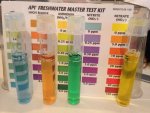Oddish
New member
Hi all,
I have a small bare bottom setup with one 4 inch axie, one moss ball, no filter and which I have been vacuuming daily with an aquarium cleaner along with water changes of approx 2 litres of matured tap water every 2 days.
It has been one week since I set up and my ph tested between 7.6 - 7.8. Nitrites and nitrates were 0ppm but ammonia was higher than I had hoped for.
I took photos of the results then tested ammonia again after a water change. It was still approaching 1.0ppm. Is this an acceptable level?
I have a small bare bottom setup with one 4 inch axie, one moss ball, no filter and which I have been vacuuming daily with an aquarium cleaner along with water changes of approx 2 litres of matured tap water every 2 days.
It has been one week since I set up and my ph tested between 7.6 - 7.8. Nitrites and nitrates were 0ppm but ammonia was higher than I had hoped for.
I took photos of the results then tested ammonia again after a water change. It was still approaching 1.0ppm. Is this an acceptable level?




